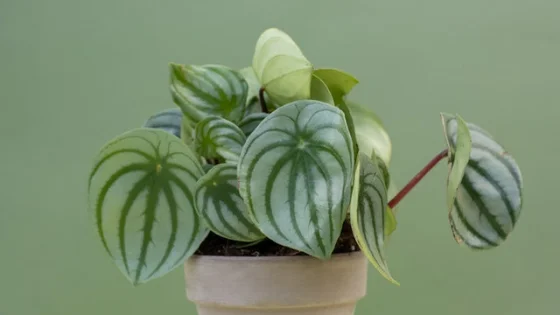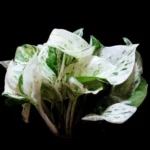Table of Contents
Caring for Peperomia Caperata
The Peperomia caperata is also known as the Emerald Ripple Peperomia. It has dark green leaves that appear wrinkled or rippled, and there are many varieties of this plant that have splashes of color in addition to the dark green.
Peperomia caperata originates from Brazilian rainforests, and it grows in a compact little mound that usually reaches about eight inches in height.
Though tropical plants can seem intimidating if you’ve never been in charge of caring for one, this little peperomia is pretty hardy and can do well even in office settings. This is one of the many reasons Peperomia caperata is so popular.
Helping Your Peperomia Caperata Thrive
While the Peperomia caperata does have preferences as to its environment, it is a pretty hardy plant. Its ideal indoor situation is something like a tropical greenhouse, but it can also do well in an office under fluorescent lights.
If your plant isn’t thriving, try to provide it with a setting that’s a bit more tropical.
Watch the leaves for signs of distress. If leaves start getting yellow and washed out, drooping, turning brown at the edges, or if the stems start turning black, these are all signs that something in the pepermoia’s environment needs to be adjusted.
Luckily, as long as they’re caught in time, any adjustments are generally pretty easy to make.
Unlike many tropical plants, the Peperomia caperata will sometimes flower even as a houseplant. It has small, non-showy, white spikes that bloom in summer.
Light Requirements
Peperomia caperata enjoys bright, indirect light. However, it’s pretty tolerant of a lot of lower light settings. the only thing it really doesn’t tolerate is direct sunlight, especially if you live in a warm climate or during summer.
In cooler climates or winter, morning sun is less likely to harm the plant, but it still prefers indirect light.
Temperature Requirements
The Peperomia caperata likes temperatures above 60 degrees Fahrenheit. Under 60 degrees risks the plant being harmed.
It appreciates warmer temperatures, with up to about 80 degrees being nice, but it will likely do very well at whatever indoor temperature you are most comfortable with.
It tolerates temperatures above 80 degrees much better than it does temperatures below 60, and you may see noticeable slowing of growth near the lower end of that range.
Soil Requirements
The Peperomia caperata likes a mix of peat and perlite in its soil. This gives it organic matter that can hold moisture, as well as non-absorbent material that can help keep moisture from overwhelming the roots.
Always be sure that your plant’s pot has proper drainage and that drainage holes don’t get blocked by solid matter.
Humidity Requirements
While the Peperomia caperata prefers high, tropical humidity, it can still do very well at average indoor humidity levels.
If you live somewhere that is particularly dry, consider adding a little ambient moisture. You can do this by providing a pebble tray underneath the pot (though be sure the pot still has proper drainage), watering multiple plants together, or by using a humidifier.
How to Water Your Peperomia Caperata
Water your Peperomia caperata about once a week. However, before watering, check the top inch or so of soil. If this is dry, it’s ready to be watered. if it’s still damp, give it a little longer.
Keep in mind that plants need a lot less water in winter than they do when they’re actively growing.
How to Fertilize Your Peperomia Caperata
Fertilize monthly during the growing seasons of spring and summer, continuing into fall in warmer climates, but holding off in winter when the plant isn’t really growing.
Dilute a regular, balanced fertilizer by half before applying, or use a fertilizer specifically formulated for tropical plants.
Pruning Your Peperomia Caperata
Prune the Peperomia caperata as needed to encourage bushy growth. If you like a more natural look to your plant, pruning is only needed for dead or damaged leaves.
Propagation of Your Peperomia Caperata
Peperomia caperata propagates well using cuttings. Clip at the stem, an inch or two below a leaf. Make sure there’s at least one leaf on the cutting.
Consider applying a root hormone. Then, plant the cutting in moist soil, and try to provide it with as tropical a setting as possible until it’s taken root.
Varieties of Peperomia Caperata
There are many different varieties or cultivars of this popular plant. For the most part, care is the same for all of these, but keep in mind that plants with variegated leaves or plants with brighter foliage may need a little bit more light than the standard Peperomia caperata.
In this event, the light should still remain indirect.
The following are some of the different varieties of Peperomia caperata:
- Peperomia caperata variegata
- Peperomia caperata rosso
- Peperomia caperata frost
- Peperomia caperata burgundy
- Peperomia caperata Argentia
Pests and Diseases
Peperomia caperata isn’t particularly prone to any pests or diseases. It can get root rot if it is overwatered too frequently, or if water is kept against the roots, such as if the soil is too dense or the pot isn’t draining.
Ridding Your Peperomia Caperata of Pests
The Peperomia caperata does occasionally get common pests, but it has relatively small leaves, so this isn’t a major problem.
If you start noticing dull leaves or leaves with small holes, check for any pests, especially under the leaves. Use a damp cloth and manually remove any pests, then apply a gentle insecticide or neem oil.
Be sure to check any nearby plants for signs the infestation has spread.
Toxicity
The Peperomia caperata is non-toxic to humans and pets. This makes it a good choice if you have pets or small children, though always keep in mind that the plant itself might not appreciate being eaten, and may still benefit from an out-of-reach location if you have anyone in your house who may chew on leaves.
Quick Reference
- Light: Indirect
- Temperature: 60-80 degrees Fahrenheit
- Soil: Peat and perlite
- Humidity: Average to high
- Water: When top 1-2 inches of soil is dry
- Pruning: As desired for a fuller appearance
Photo by EKATERINA BOLOVTSOVA from Pexels


